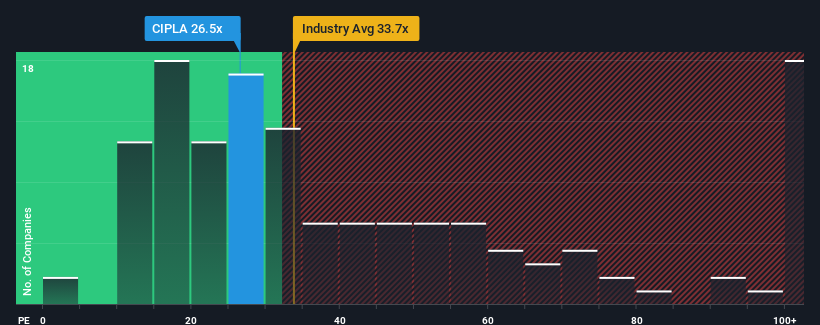Why Investors Shouldn't Be Surprised By Cipla Limited's (NSE:CIPLA) Low P/E

Cipla Limited's (NSE:CIPLA) price-to-earnings (or "P/E") ratio of 26.5x might make it look like a buy right now compared to the market in India, where around half of the companies have P/E ratios above 32x and even P/E's above 61x are quite common. Although, it's not wise to just take the P/E at face value as there may be an explanation why it's limited.
With earnings growth that's superior to most other companies of late, Cipla has been doing relatively well. One possibility is that the P/E is low because investors think this strong earnings performance might be less impressive moving forward. If you like the company, you'd be hoping this isn't the case so that you could potentially pick up some stock while it's out of favour.
View our latest analysis for Cipla

How Is Cipla's Growth Trending?
The only time you'd be truly comfortable seeing a P/E as low as Cipla's is when the company's growth is on track to lag the market.
Retrospectively, the last year delivered an exceptional 30% gain to the company's bottom line. The strong recent performance means it was also able to grow EPS by 73% in total over the last three years. So we can start by confirming that the company has done a great job of growing earnings over that time.
Turning to the outlook, the next three years should generate growth of 6.0% per year as estimated by the analysts watching the company. That's shaping up to be materially lower than the 20% per year growth forecast for the broader market.
In light of this, it's understandable that Cipla's P/E sits below the majority of other companies. Apparently many shareholders weren't comfortable holding on while the company is potentially eyeing a less prosperous future.
The Final Word
It's argued the price-to-earnings ratio is an inferior measure of value within certain industries, but it can be a powerful business sentiment indicator.
We've established that Cipla maintains its low P/E on the weakness of its forecast growth being lower than the wider market, as expected. At this stage investors feel the potential for an improvement in earnings isn't great enough to justify a higher P/E ratio. Unless these conditions improve, they will continue to form a barrier for the share price around these levels.
A lot of potential risks can sit within a company's balance sheet. Our free balance sheet analysis for Cipla with six simple checks will allow you to discover any risks that could be an issue.
Of course, you might also be able to find a better stock than Cipla. So you may wish to see this free collection of other companies that have reasonable P/E ratios and have grown earnings strongly.
New: AI Stock Screener & Alerts
Our new AI Stock Screener scans the market every day to uncover opportunities.
• Dividend Powerhouses (3%+ Yield)
• Undervalued Small Caps with Insider Buying
• High growth Tech and AI Companies
Or build your own from over 50 metrics.
Have feedback on this article? Concerned about the content? Get in touch with us directly. Alternatively, email editorial-team (at) simplywallst.com.
This article by Simply Wall St is general in nature. We provide commentary based on historical data and analyst forecasts only using an unbiased methodology and our articles are not intended to be financial advice. It does not constitute a recommendation to buy or sell any stock, and does not take account of your objectives, or your financial situation. We aim to bring you long-term focused analysis driven by fundamental data. Note that our analysis may not factor in the latest price-sensitive company announcements or qualitative material. Simply Wall St has no position in any stocks mentioned.
About NSEI:CIPLA
Cipla
Manufactures, develops, sells, and distributes pharmaceutical products in India, the United States, South Africa, and internationally.
Flawless balance sheet with solid track record and pays a dividend.
Market Insights
Community Narratives



